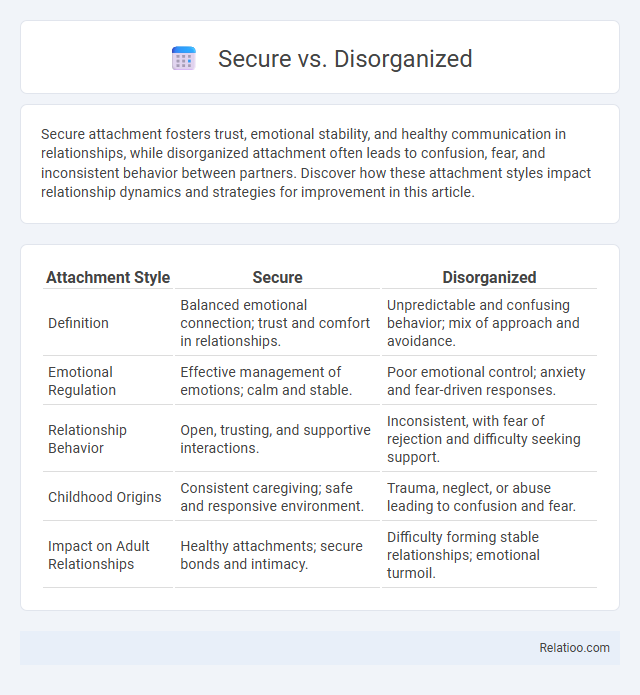Secure attachment fosters trust, emotional stability, and healthy communication in relationships, while disorganized attachment often leads to confusion, fear, and inconsistent behavior between partners. Discover how these attachment styles impact relationship dynamics and strategies for improvement in this article.
Table of Comparison
| Attachment Style | Secure | Disorganized |
|---|---|---|
| Definition | Balanced emotional connection; trust and comfort in relationships. | Unpredictable and confusing behavior; mix of approach and avoidance. |
| Emotional Regulation | Effective management of emotions; calm and stable. | Poor emotional control; anxiety and fear-driven responses. |
| Relationship Behavior | Open, trusting, and supportive interactions. | Inconsistent, with fear of rejection and difficulty seeking support. |
| Childhood Origins | Consistent caregiving; safe and responsive environment. | Trauma, neglect, or abuse leading to confusion and fear. |
| Impact on Adult Relationships | Healthy attachments; secure bonds and intimacy. | Difficulty forming stable relationships; emotional turmoil. |
Understanding Secure vs Disorganized: Core Differences
Understanding the core differences between secure and disorganized attachment styles reveals how secure individuals display trust, emotional regulation, and healthy relationships while disorganized attachment often results in confusion, fear, and inconsistent behavior. Your ability to recognize these patterns can improve emotional intelligence and interpersonal connections by promoting awareness of how attachment influences responses to stress and intimacy. Insights into secure versus disorganized attachment help target personal growth and foster stable, supportive relationships.
Defining Secure Attachment
Secure attachment is characterized by consistent responsiveness and emotional availability from caregivers, fostering trust and a positive self-image in children. This attachment style promotes healthy emotional regulation, effective communication, and resilience in relationships. In contrast, disorganized attachment involves a lack of clear attachment behavior, often linked to trauma or neglect, leading to confusion and difficulty in forming secure bonds.
What is Disorganized Attachment?
Disorganized attachment describes a contradictory and confused pattern of behavior in relationships, often stemming from trauma or inconsistent caregiving during childhood. It is characterized by a lack of clear strategy to seek comfort, leading to fear or anxiety in close connections. Understanding your attachment style, including disorganized attachment, can empower you to build healthier emotional bonds and improve your relational well-being.
Causes of Secure and Disorganized Patterns
Secure attachment patterns develop from consistent, responsive caregiving where caregivers meet your emotional needs, fostering trust and emotional regulation. Disorganized attachment arises from unpredictable, frightening, or neglectful caregiving, leading to confusion and difficulty in managing emotions. Understanding these causes helps you recognize how early relationships impact your attachment style and interpersonal dynamics.
Behavioral Traits: Secure vs Disorganized
Secure attachment behavior exhibits confidence, effective emotion regulation, and trust in relationships, fostering healthy social interactions. Disorganized attachment is marked by inconsistent responses, fear, and confusion, often resulting in unpredictable or self-destructive actions. Understanding your behavioral traits can inform strategies to improve emotional stability and interpersonal connections.
Emotional Impact on Individuals
Secure attachment fosters emotional resilience and healthy relationships, enabling you to navigate stress and connect deeply with others. Disorganized attachment often results in emotional confusion and anxiety, causing difficulty in managing feelings and trusting others. Avoidant attachment typically leads to emotional distancing and suppression, hindering authentic connection and vulnerability in personal interactions.
Long-term Effects of Attachment Styles
Secure attachment fosters healthy emotional regulation and stable relationships, promoting resilience and psychological well-being throughout life. Disorganized attachment often leads to difficulties in trust and emotional instability, increasing the risk of mental health disorders such as anxiety and depression. Long-term effects of attachment styles influence interpersonal functioning, coping strategies, and overall life satisfaction, with secure attachment linked to better social and emotional outcomes.
Addressing Disorganization: Steps Toward Security
Addressing disorganization begins with recognizing patterns of inconsistency in attachment and emotional regulation that characterize the disorganized style. You can implement structured routines and seek therapeutic interventions that promote trust and emotional stability, fostering the development of a secure attachment. Prioritizing consistent, reliable interactions strengthens your ability to form secure connections and reduces emotional confusion.
Secure Relationships: Building Trust and Stability
Secure relationships foster trust and stability through consistent communication, emotional responsiveness, and mutual respect, creating a foundation for healthy attachments. Individuals with secure attachment styles exhibit confidence in their partners, promoting intimacy while effectively managing conflicts and stress. This stability enhances overall relationship satisfaction and supports long-term emotional well-being for both partners.
Healing Strategies for Disorganized Attachment
Healing strategies for disorganized attachment emphasize creating a consistent and safe environment that fosters trust and emotional regulation. Therapeutic approaches such as trauma-informed therapy, attachment-based interventions, and mindfulness practices support individuals in integrating conflicting internal models and developing secure relational patterns. Consistent caregiver responsiveness and reflective functioning play critical roles in transforming disorganized attachment into secure attachment over time.

Infographic: Secure vs Disorganized
 relatioo.com
relatioo.com